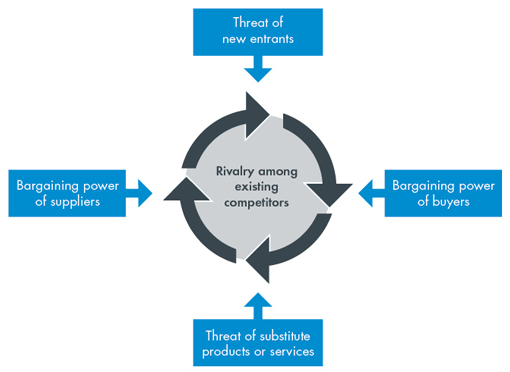What Are Porter’s Five Forces?
Porter’s Five Forces is a representation that classifies and evaluates five competitive forces which regulates and frames every industry with the purpose of identifying its weaknesses and strengths.
This analysis is often times used to elaborate a corporate strategy by bringing up and industry’s structure.
This model is ought to be practiced in any segment of the economy with the purpose of reaching a holistic knowledge about the competition level within the target industry and intensify a company’s long-term profitability.

Understanding Porter’s Five Forces
Porter’s five forces are:
1. Competition in the industry
2. Potential of new entrants into the industry
5. Threat of substitute products
Competition in the Industry
The primary that thing that the model focuses on is the number of the competitors present in the industry and their capacity to undercut a company. The higher the number of these competitors as well as the number of the similar products, the less is the chance of the company to occupy higher positions.
Suppliers and buyers look out for the companies’ competition capacity with the aim of selecting the best alternatives in terms of better deals and lower prices.
Reversely, the lower the competitive rivalry, the higher the power of a company to impose its own prices and the terms of the deals to gain and reach higher sales and profits.
Potential of New Entrants into an Industry
New entrances also remain a strong concern when it comes to a company’s willingness to keep a good market positioning. That is, a company’s position may be highly affected or even weakened if a new entrance manages to gain time and cut costs while integrating the target market.
Hence, an already existing company would rather choose an industry with strong barriers to decrease the risk of loss of position and enhance their ability to negotiate more favorable terms and set higher prices which results in its turn in higher gains and profits.
Power of Suppliers
Suppliers’ power is also an important factor to consider in this model. It addresses the ability of the suppliers to drive up the costs of inputs and raw materials.
This factor is affected by the total number of the suppliers and their ability to provide the raw materials/primary inputs that are further used in the production process/service establishment, the rarity of the input itself and, of course, the cost implied on switching between different investors.
No doubt that the fewer the suppliers in an industry, the higher would be the price to pay for their services. Hence, they will have more power in setting the prices and work on establishing strategies and trade agreements where they would gain the maximum of profits.
Adversely, when the number is low resulting in a decreased switching cost between rival suppliers, a company is ought to minimize cost and maximize its profits.
Power of Customers
This factor implies considering the customer ability to drive prices (Demand part). It is impacted by the number of customers and their significance level according to the company and the business’ budgeting policy in terms of costs dedicated to new customer acquisition.
A smaller and more important the client base results in an increased customer’s ability to negotiate for more adequate and preferred prices and better agreements.
The larger that base is, the easier it is for the company to charge higher prices in its market niche/segment.
Threat of Substitutes
The last of the Porter’s Five Forces factor is the threat of substitutes. This is a continues race of improving the quality of products and its importance to the end users/consumers.
The higher the number of the substitutes of a product, the more at risk the company is to lose its customer base to its rivals. When close substitutes are available, customers will be able to forgo buying a certain company’s product and hence weaken its power.
On the other hand, the less product substitutes a company faces, the higher is its chance to occupy important positions.
As a conclusion, the Five Forces model is a useful and helpful tool for the businesses to boost their profits, identify opportunities, minimize risk of failure and be up to date with the ongoing of the market especially when it comes to its rivals in order to have flexible strategies and a continues adjustments for a greater gain.
| References |
| 1. Business Plan: Porter’s Five Forces, accessed October 2020, https://www.mindtools.com/pages/article/newTMC_08.htm |

Leave A Comment?